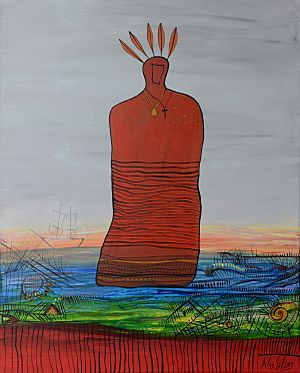Henri Membertou facts for kids
Quick facts for kids
Grand Chief
Henri Membertou
|
|
|---|---|
| Born | c. 1507 Southwestern St. Mary's Bay
|
| Died | 18 September 1611 (aged 102/103) Port Royal, Canada
|
| Occupation | Grand Chief of the Mi'kmaq people |
| Years active | 1550-1611 |
| Title | sakmow (Grand Chief) |
Grand Chief Henri Membertou (born around 1507 – died September 18, 1611) was a very important leader of the Mi'kmaq First Nations people. He was known as the sakmow, or Grand Chief, of their tribe. His people lived near Port Royal, which is where the first French settlement in Acadia was built. Today, this area is part of Nova Scotia, Canada.
Membertou was originally the sakmow for the Kespukwitk district. Later, the leaders of the other six Mi'kmaq districts chose him to be the Grand Chief. He claimed he was already an adult when he met the explorer Jacques Cartier. This means he was likely born in the early 1500s.
Contents
A Powerful Mi'kmaq Leader
Before becoming Grand Chief, Membertou was the District Chief of Kespukwitk. This area included where the French colonists later built Port-Royal. Besides being a political leader (sakmow), Membertou was also the main spiritual leader (autmoin) of his tribe. People believed he had special powers to heal others and to see into the future.
Membertou was smart and resourceful. He even got his own French shallop, which is a type of small boat. He decorated it with his tribe's special symbols. He used this boat to trade with Europeans far out at sea. This gave him the first chance to sell goods, which meant he could get better deals.
Membertou became a good friend to the French. He first met them in 1605 when they arrived to build the Habitation at Port-Royal. The French writer Marc Lescarbot said that Membertou claimed to be over 100 years old at that time. He even remembered meeting Jacques Cartier way back in 1534.
Both Lescarbot and the famous explorer Samuel de Champlain wrote about Membertou. They saw him lead a funeral in 1606 for another Mi'kmaw leader named Panoniac. Panoniac had been killed by the Armouchiquois, a tribe from what is now Maine. Membertou led 500 warriors to seek justice against the Armouchiquois in July 1607.
The Jesuit priest Pierre Biard described Membertou as being different from other Mi'kmaq men. He kept a beard, while others removed their facial hair. Membertou was also larger than most men. Even though he was very old, he had no grey or white hair. Unlike many leaders who had several wives, Membertou had only one wife, who was later baptized and named Marie.
Lescarbot wrote about Membertou's children. His oldest son was called Membertouchis (or Membertouji'j), who was later baptized Louis Membertou. His other sons were Actaudin and Actaudinech (Actaudinji'j), with Actaudinech being baptized Paul Membertou. He also had a daughter named Marguerite.
When the French left in 1607, they left only two people behind. Membertou took good care of the fort and these two Frenchmen. He was there to greet the French when they returned in 1610.
Membertou's Music
Three of Membertou's songs have been written down, making them the first music from the Americas to be recorded. The melodies for these songs were written using solfège notation by Marc Lescarbot. Solfège uses syllables like Do, Re, Mi to represent musical notes.
Later, the time values of each note were recorded by Gabriel Sagard-Théodat. This was done using a system called mensural notation. The melodies use three notes, which were originally Re-Fa-Sol. Today, they are easier to sing as La-Do-Re. You can even find versions of these songs for the Native American flute.
A Historic Baptism
On June 24, 1610, which is Saint John the Baptist Day, Membertou made history. He became the first Indigenous leader to be baptized by the French. This was an important sign of friendship and trust between the Mi'kmaq and the French.
Priest Jessé Fléché performed the ceremony. After Membertou, all 21 members of his immediate family were also baptized. Membertou was given the baptismal name Henri, in honor of the late King Henry IV of France. This event was a big step for the Mi'kmaq people. It began their special relationship with the Catholic Church, known as the Mi'kmaw Concordat.
Later Life and Legacy

After his baptism, Membertou was very eager to learn more about Christianity. He wanted the missionaries to learn the Mi'kmaq language. This way, he and his people could be properly taught.
Priest Biard shared a story about Membertou's son, Actaudin, who became very sick. Membertou was ready to perform a traditional sacrifice of dogs to help his son. But when Biard told him this was not part of Christian beliefs, Membertou listened. Actaudin then got better.
In 1611, Membertou became very ill with dysentery. This was one of the many diseases that Europeans brought to the New World. By September 1611, he was very sick. At first, Membertou wanted to be buried with his ancestors, which worried the missionaries. However, he soon changed his mind. He asked to be buried among the French.
Grand Chief Henri Membertou passed away on September 18, 1611. He was about 102 or 103 years old. In his last words, he told his children to remain strong in their Christian faith.
In 2007, Canada Post honored Chief Membertou with a special stamp. It was part of their "French Settlement in North America" series.
A beautiful portrait of Membertou was painted by the famous Mi'kmaq artist, Alan Syliboy. This painting was given to Queen Elizabeth II during her visit to Canada in 2010. You can see this portrait on display at Government House (Nova Scotia).
See also
- List of Grand Chiefs (Mi'kmaq)
- Order of Good Cheer


